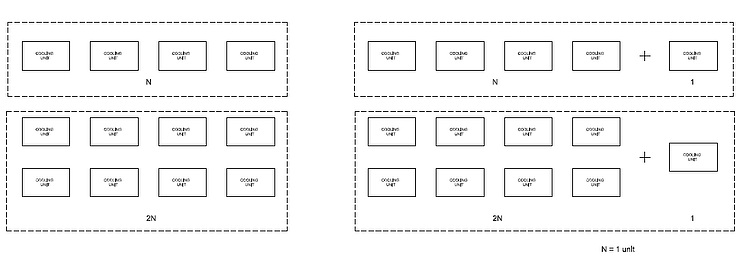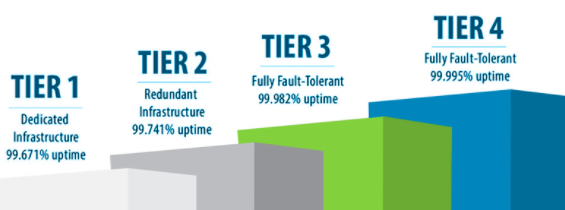As companies increasingly rely on data centers for their business operations and digital infrastructure, ensuring a high level of security and reliability in terms of redundancy becomes paramount for data center infrastructure providers. Let's explore the details of data center redundancy.
What is redundancy in Data Centers
Redundancy in data centers refers to a system design where components are duplicated to ensure that in the event of any power outage, equipment failure or any unexpected breakage, the IT equipment will not be affected in an alarming way. A good example could be having power redundancy in case of an outage.
The Maximum Tolerable Period of Disruption (MTPD) is decreasing because most companies are having less tolerance for their business and operations. ITIC (Information Technology Industry Council) released an annual survey explaining that 98% of companies said that 1h of downtime could cost over 100,000$.
Benefits of Data Center redundancy
Implementing redundancy in data centers offers several benefits:
-
Enhanced Reliability: Redundancy ensures uninterrupted operation, minimizing the risk of downtime and data loss.
-
Improved Performance: By having redundant systems in place, data centers can maintain optimal performance even during equipment failures or maintenance activities.
-
Scalability: Redundancy allows for easy scalability and expansion of data center infrastructure as business needs grow.
Data Center Power Redundancy
The primary concern for data centers is to avoid downtime, and that is usually the driver for data center redundancy. This includes data center power redundancy, cooling redundancy, and multiple telecom entrances.
Data center power redundancy involves connecting two or more utility feeds, generators, UPS systems, and outlets to each rack. Although it is rare, a device can fail, leaving you with an outage of service while the flow of power is interrupted. With redundant power in our Data Centers, you minimize this risk of this happening by connecting to an independent power system within the data center.
The truth is that this redundancy approach not only reduces downtime associated with failures but also streamlines maintenance requirements.
Keep reading: Data Center Role: A Current Look
Different Levels of Redundancy
Redundancy in data centers is measured in N classifications, where N means a basic measure of functionality and represents a duplicate unit (e.g., CRAH unit, diesel generator, UPS). A higher N value indicates greater redundancy, so an N-type design means no redundancy.
It represents the infrastructure necessary to keep a data center operating at full capacity and under a specific workload. In the event of any failure, some major equipment and services would be affected.
1. N-type Design:
Represents the infrastructure necessary to keep a data center operating at full capacity but with no redundancy.
2. N+1 Redundancy:
Provides one extra unit for every four needed, ensuring backup in case of failure or maintenance, i.e. there is a backup to fall back on in case of failure or maintenance.
3. N+2 Redundancy:
Offers a completely redundant system, with two extra component units for every four in use, allowing extensive maintenance without downtime.
That is, if one power source has a failure, the other must still supply power and accommodate the full load, thus eliminating any potential downtime due to the loss of one side of the system. Generally, this allows a data facility to support more extensive maintenance while maintaining the full workload.

Data Center TIERS and Redundancy
Redundancy is important in measuring data center reliability, performance and availability, as are many additional elements. The Uptime Institute offers a tiered classification system that certifies data centers according to four different levels: Level 1, Level 2, Level 3 and Level 4.
Therefore, the TIER classification is a standardized methodology according to the official ANSI/TIA-942 standard:
TIER I
Dedicated Infrastructure (99.671% uptime).
Basic data center with no redundant components. This is a suitable design for business that tolerate planned shutdown periods.
TIER II
Redundant Infrastructure (99.741% uptime).
Redundant data centers (N+1). These ones include all of the TIER I capabilities and add extra redundancy for critical equipment such as power equipment (UPS, generators…) and cooling systems (HVAC, pumps and chillers).
TIER III
Fully Fault-Tolerant (99.982% uptime)
Redundant data centers (N+1). These ones include all of the TIER I and TIER II capabilities and add extra redundancy. The equipment is connected to more than one power and cooling networks, with only one active. This is suitable for business than can’t tolerate large shutdowns due to the extremely importance of data stored.
TIER IV
Fully Fault-Tolerant (99.995% uptime).
Annual availability of 99.9995%. Maximum annual shutdown of 52.56 min. The systems are connected to multiple power and cooling networks with multiple redundant equipment, following the 2(N+1) criteria.
It may interest you: How efficient is your data center?
Best practices for implementing Data Center redundancy
To ensure effective redundancy, consider the following best practices:
-
Conduct risk assessment: Identify potential points of failure and determine the required level of redundancy.
-
Utilize redundant power supplies: Ensure continuous operation by using redundant power supplies for critical equipment.
-
Regular testing: Test redundant systems regularly to ensure they function as intended.
-
Implement monitoring and maintenance procedures: Detect and address issues before they lead to downtime.
How efficient is your Data Center?
Data centers are a critical part of your business and choosing the right architecture and redundancy model that meets your requirements can be a major challenge. An ineffective data center redundancy model can have devastating consequences for your business.
Achieving maximum performance and reliability in your data center requires effective redundancy. Therefore, it will be critical that you can rely on a trusted provider to offer you a certain level of security and assurance in terms of redundancy.
There is no right or wrong redundancy system, as it will depend on many factors. At ARANER, we understand the critical role of redundancy in data centers and offer tailored solutions to meet your requirements. Contact our team of professionals for a personalized evaluation and recommendations based on your data center needs. Ensure maximum performance with Araner!











